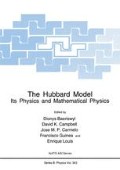Abstract
In recent years the slave-boson method1 has been applied to a large variety of strongly correlated problems including the Kondo impurity and lattice2, the Anderson Hamiltonian3, and the Hubbard model(s)4. The method, which maps the physical electron destruction operator c σ with spin σ into products of new fermions d σ and bosons b, has been usually treated within a functional integral representation of the partition function since this representation suitably enforces the constraints of the theory and allows for a large-N expansion, which is free from infrared divergences in the so-called radial gauge5,6. Despite the large literature in the field, it appears that few analises have been carried out on the quantitative reliability of the method. This point was addressed by Zhang, Jain, and Emery7 for a two-level single-site problem. They concluded that the slave boson approach and the large N expansion were inadequate to reproduce the known exact results for this simple model. In Ref.[7], as in all previous literature, it was assumed that the continuum imaginary time limit (which is implicit in any path integral definition) can be safely taken at the outset in the effective action.
Access this chapter
Tax calculation will be finalised at checkout
Purchases are for personal use only
Preview
Unable to display preview. Download preview PDF.
References
The slave-boson method has been introduced by S.E. Barnes [J. Phys. F 6, 1375 (1976)] and
P. Coleman [Phys. Rev. B 29, 3035 (1984)].
P. Coleman, Ref.1
N. Read and D.M. Newns, J. Phys. C 16, 3273 (1983)
A. Auerbach and K. Levin, Phys. Rev. Lett. 57, 877 (1986).
S.E. Barnes, Ref.1 and J. Phys. F 7, 2637 (1977)
A.J. Millis and P.A. Lee, Phys. Rev. B 35, 3394 (1987).
G. Kotliar and A.E. Ruckenstein, Phys. Rev. Lett. 57, 1362 (1986).
N. Read, J. Phys. C 18, 2651 (1985).
For an exhaustive list of references, see N.E. Bickers, Rev. Mod. Phys. 59, 845 (1987).
L. Zhang, J.K. Jain, and V.J. Emery, Phys. Rev. B46, 5599 (1992).
E. Arrigoni, C. Castellani, R. Raimondi, and G.C. Strinati submitted for publication (1993).
Cf., e. g., L.S. Schulman, Techniques and applications of path integration (J. Wiley, New York, 1981).
The contribution originating from the measure in the radial gauge is implicit in (5).
We have found it troublesome to compare our results for the Gaussian fluctuations in the continuum limit with the results given in Ref.[7], because of several apparent inconsistencies found in the expressions of Ref.[7] (corrected yet of evident misprints). Nonetheless, we were able to compare numerically our results with Fig.2 of Ref.[7] for the case Δ/t = 4.0 (where \( r_0^2 \to 0 \)), provided we assign a missing factor 1/2 to the fluctuation contribution in Eq.(38) of Ref.[7].
Author information
Authors and Affiliations
Editor information
Editors and Affiliations
Rights and permissions
Copyright information
© 1995 Springer Science+Business Media New York
About this chapter
Cite this chapter
Arrigoni, E., Castellani, C., Raimondi, R., Strinati, G.C. (1995). Revising the 1/N Expansion for the Slave-Boson Approach within the Functional Integral. In: Baeriswyl, D., Campbell, D.K., Carmelo, J.M.P., Guinea, F., Louis, E. (eds) The Hubbard Model. NATO ASI Series, vol 343. Springer, Boston, MA. https://doi.org/10.1007/978-1-4899-1042-4_22
Download citation
DOI: https://doi.org/10.1007/978-1-4899-1042-4_22
Publisher Name: Springer, Boston, MA
Print ISBN: 978-1-4899-1044-8
Online ISBN: 978-1-4899-1042-4
eBook Packages: Springer Book Archive

